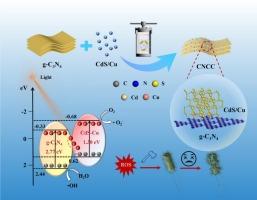Construction of g-C3N4/CdS-Cu Z-scheme heterojunction with reactive oxygen species compensation function and analysis of its photocatalytic antibacterial mechanism
IF 6.9
2区 材料科学
Q2 CHEMISTRY, PHYSICAL
引用次数: 0
Abstract
Photocatalytic antibacterial materials, which kill bacteria by generating reactive oxygen species (ROS) without relying on metal ion components, offer higher safety and environmental friendliness, making them a key focus of current antibacterial research. Traditional photocatalytic materials exhibit limited responsiveness to visible light, and their antibacterial efficacy diminishes when the generation of ROS is suppressed. Therefore, this study developed a g-C3N4/CdS-Cu Z-scheme heterojunction with strong visible light responsiveness, enabling the generation of alternative ROS when one type is inhibited. The material exhibited excellent antibacterial performance under visible light, with antimicrobial rates of 95.46 % and 95.91 % against E. coli and S. aureus, respectively. Microstructural and photoelectric analyses confirmed that the material possessed a tightly coupled two-dimensional heterostructure with full-spectrum absorption capacity and efficient separation of photogenerated charge carriers. Additionally, density functional theory (DFT) calculations revealed changes in electron transfer pathways and energy band structure, further supporting the proposed antibacterial mechanism. In practical application tests, g-C3N4/CdS-Cu showed good performance in water treatment. This study on the “ROS compensation” mechanism provides a theoretical basis for the development of advanced photocatalytic antibacterial materials and expands their application range.

具有活性氧补偿功能的g-C3N4/CdS-Cu Z-scheme异质结的构建及其光催化抗菌机理分析
光催化抗菌材料不依赖金属离子成分,通过产生活性氧(ROS)杀死细菌,具有更高的安全性和环境友好性,是当前抗菌研究的重点。传统的光催化材料对可见光的响应性有限,当ROS的产生受到抑制时,其抗菌效果就会下降。因此,本研究开发了一种具有强可见光响应性的g-C3N4/CdS-Cu Z-scheme异质结,当一种类型的ROS被抑制时,可以产生替代ROS。在可见光下,该材料对大肠杆菌和金黄色葡萄球菌的抑菌率分别为95.46 %和95.91 %。显微结构和光电分析证实,该材料具有紧密耦合的二维异质结构,具有全光谱吸收能力和高效分离光生载流子的能力。此外,密度泛函理论(DFT)计算揭示了电子转移途径和能带结构的变化,进一步支持了所提出的抗菌机制。在实际应用试验中,g-C3N4/CdS-Cu表现出良好的水处理性能。对“ROS补偿”机制的研究,为开发先进的光催化抗菌材料提供了理论依据,拓展了其应用范围。
本文章由计算机程序翻译,如有差异,请以英文原文为准。
求助全文
约1分钟内获得全文
求助全文
来源期刊

Applied Surface Science
工程技术-材料科学:膜
CiteScore
12.50
自引率
7.50%
发文量
3393
审稿时长
67 days
期刊介绍:
Applied Surface Science covers topics contributing to a better understanding of surfaces, interfaces, nanostructures and their applications. The journal is concerned with scientific research on the atomic and molecular level of material properties determined with specific surface analytical techniques and/or computational methods, as well as the processing of such structures.
 求助内容:
求助内容: 应助结果提醒方式:
应助结果提醒方式:


